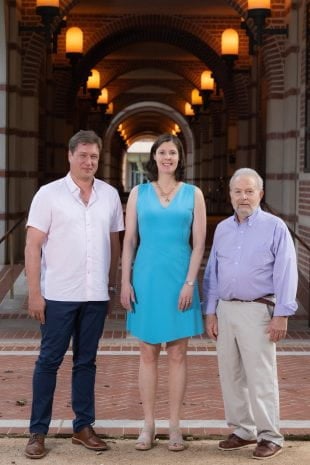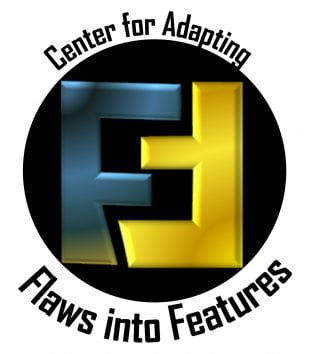HOUSTON – (Aug. 3, 2021) – There's a saying among programmers who make excuses for flaws in their code: "That's not a bug, that’s a feature!" Chemists at Rice University are taking the concept far more seriously.
A multiuniversity team led by Rice chemist Christy Landes has landed a National Science Foundation grant to establish the NSF Phase 1 Center for Adapting Flaws into Features (CAFF). Its goal is to exploit chemical defects that show the potential for unique reactivity to optimize the structural and electronic properties of materials.
The award is a three-year Phase 1 grant for $1.8 million through NSF's Centers for Chemical Innovation Program. It will allow Landes and her team to make their case for a longer-term Phase II award to explore "high-risk" ideas and new approaches toward transformative technologies.
The team includes Rice chemists Stephan Link and Peter Rossky, along with scientists from Stanford University, the University of Illinois at Urbana-Champaign, Stony Brook University, the University of Texas at Austin and the University of Wisconsin.
Specifically, the center intends to take advantage of what the researchers call "the messy reality" of microscopic flaws in materials to make better catalysts and coatings and more efficient electronics, for starters.
Flaws can be as simple as a missing atom in a 2D lattice that allows small molecules through, or a mismatched arrangement of atoms at the interface of two materials that affects how electricity flows between them.
"There are tons of examples, not just in chemistry but all sorts of things," said Landes, the Kenneth S. Pitzer-Schlumberger Chair Professor of chemistry, and a professor of electrical and computer engineering and chemical and biomolecular engineering. "One is iron. We like to say something is strong like iron, but the truth is, pure iron is not strong at all.
"It's easily rusted, and is too soft in its pure form to be of any use in structures," she said. "But by adding small amounts of impurities like carbon and nickel, you can turn it into an incredible material, steel.
"It's the same on the molecular level," Landes said. "A pure, flat surface with all the chemical bonds satisfied is often not a great catalyst. And silicon without additives would not be the right semiconductor for many applications."
Landes and her colleagues' expertise in advanced microscopy and spectroscopy makes them uniquely suited to characterize molecular reactions with an eye toward optimization.
"We're physical chemists, and in general we don’t make new materials, perfect or flawed," she said. "What we do is study materials to understand how their flaws contribute to their properties. To do that, we need to measure them, image them and take spectra with a level of detail that lets us distinguish the chemistry happening at the defect versus other sites in the material."
Landes said materials often either fail or function at an interface, for instance in the layers of a vehicle's catalytic converter. Measuring a catalyst’s entire performance only provides an average, but knowing which defects are optimal and why can lead to better-engineered devices.
"We have pioneered imaging and spectroscopy techniques among our team that are incredibly important for this," she said. "Stephan's group has a way to do hyperspectral single-particle spectroscopy, which allows us to look not just at one reaction at a time, but also see the chemical changes over time. That lets us follow a chemical reaction for many particles."
She noted co-investigators Martin Gruebele at Illinois and Jennifer Dionne at Stanford have imaging instruments able to reveal the dynamics of nanoscale objects.
"In order for energy transfer, charge transfer or a chemical reaction to happen, nanomaterials have to go through some higher excited state," Landes said. "Martin's instrument is, to my knowledge, the only one in the world that allows us to do that on real materials with that level of detail."
Incorporating modern theoretical modeling and data science into CAFF will be critical, Landes said, and the center is designed with the convergence of these capabilities in mind.
She noted that while experimental imaging accesses ever-smaller dimensions, theoretical modeling at the scale of electrons and atoms has advanced in parallel. Theorists Rossky and Benjamin Levine will provide a direct view of the mechanisms behind newly observed nanoscale dynamics.
Rice's strength in data science will be critical as well. "It used to be a study that took days would produce five data points, but they would be equally cherished and important, and enough to write a paper about," she said.
"Now, in a single afternoon, a hyperspectral movie in 3D can give us gigabytes, and we need to develop the best possible tools to distinguish the tiny flaws from a vast amount of data," Landes said.
The "smart" tools they plan to develop will adapt in time, space and spectral resolution to allow chemists, biophysicists, engineers and materials scientists to study subpopulations of defects and more easily adapt them into desirable features.
Landes said CAFF will incorporate outreach to K-12 programs and tap into diverse community college networks near the participating institutions. "Our Phase I partner community colleges represent both underrepresented urban and underserved rural communities, allowing us to reach a diverse set of students who can form the future of American science," she said.
She noted the center also plans a monthly Flaws to Features webinar featuring civic scientists and moderated by students, with topics including history, current science and professional development as well as "hackathons" relevant to CAFF's central research.
"Through a suite of complementary analytical and physical chemical techniques, the collaborative Phase I Center for Adapting Flaws into Features aims to better characterize molecular defects at the atomic and nanoscale, and understand how these defects lead to key properties of the materials, surfaces and interfaces in which they are incorporated," said NSF Chemistry Division Director Dave Berkowitz. "This combined experimental and theoretical approach has the potential to inform how molecular defects can be designed, engineered at the atomic level and exploited to control macroscale-level outcomes, properties and behavior, potentially leading to transformative impacts in the chemical sciences and industries."
Co-investigators at CAFF include Benjamin Levine, the IACS Endowed Professor of Chemistry at Stony Brook; Sean Roberts, an associate professor of chemistry at UT Austin; and Martin Zanni, the Meloche-Bascom Professor of Chemistry at the University of Wisconsin-Madison.
Link is the Charles W. Duncan, Jr.-Welch Chair and a professor of chemistry and of electrical and computer engineering. Rossky is the Harry C. and Olga K. Wiess Chair in Natural Sciences and a professor of chemistry and of chemical and biomolecular engineering. Gruebele is the James R. Eiszner Endowed Chair in Chemistry at Illinois. Dionne is an associate professor of materials science and engineering at Stanford.
-30-
Read the grant abstract at: https://www.nsf.gov/awardsearch/showAward?AWD_ID=2124983
Related materials:
NSF Center for Adapting Flaws into Features: https://nsfcaff.org
Landes Research Group: https://lrg.rice.edu
Link Research Group: http://slink.rice.edu
Rice Department of Chemistry: https://chemistry.rice.edu
Wiess School of Natural Sciences: https://naturalsciences.rice.edu
Images for download:
https://news-network.rice.edu/news/files/2021/07/0726_CAFF-1-web.jpg
CAPTION: Rice University chemists, from left, Stephan Link, Christy Landes and Peter Rossky will establish the NSF Phase 1 Center for Adapting Flaws into Features to investigate nanoscale chemical phenomena and optimize the structures and electronic properties of materials. (Credit: Jeff Fitlow/Rice University)
https://news-network.rice.edu/news/files/2021/08/CAFF-b4.jpg
Center for Adapting Flaws into Features logo
This news release can be found online at news.rice.edu.
Follow Rice News and Media Relations via Twitter @RiceUNews.
Located on a 300-acre forested campus in Houston, Rice University is consistently ranked among the nation’s top 20 universities by U.S. News & World Report. Rice has highly respected schools of Architecture, Business, Continuing Studies, Engineering, Humanities, Music, Natural Sciences and Social Sciences and is home to the Baker Institute for Public Policy. With 3,978 undergraduates and 3,192 graduate students, Rice’s undergraduate student-to-faculty ratio is just under 6-to-1. Its residential college system builds close-knit communities and lifelong friendships, just one reason why Rice is ranked No. 1 for lots of race/class interaction and No. 1 for quality of life by the Princeton Review. Rice is also rated as a best value among private universities by Kiplinger’s Personal Finance.



